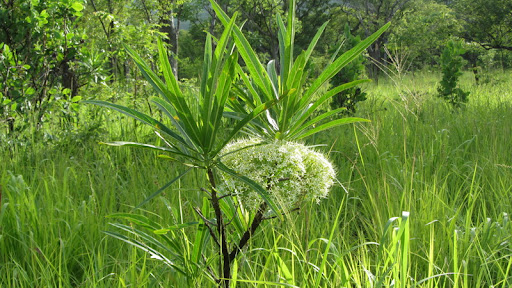Pavetta crassipes

|
|
Pavetta crassipes Common Names: Savannah Pavetta, Guinea Coffee Scientific Classification Kingdom: Plantae Clade: Tracheophytes Clade: Angiosperms Clade: Eudicots Order: Gentianales Family: Rubiaceae Genus: Pavetta Species: P. crassipes Binomial Name: Pavetta crassipes K.Schum. Synonyms: Pavetta barteri Dawe, Pavetta crassipes var.
major De Wild., Pavetta utilis Hua Morphological Description Pavetta crassipes is a glabrous evergreen shrub or small tree, typically
growing 2–6 m tall, occasionally reaching 8 m. It features: · Bark: Pale, corky, peeling in strips, greyish-white · Branches: Stout, sub-quadrangular, often reddish-brown when young · Leaves: Opposite, elliptic to obovate, 5–15 cm long, glossy dark
green, leathery · Flowers: White, tubular, 1–2 cm long, in dense terminal corymbs,
fragrant · Fruit: Spherical drupes, 6–8 mm in diameter, green turning black
when ripe It flowers during the
rainy season, enhancing savanna biodiversity (Irvine, 1961). Distribution and Habitat Pavetta crassipes is widely distributed across tropical Africa, from Senegal
and Guinea in West Africa to Tanzania and Uganda in East Africa. It thrives in: · Habitats: Savannas, woodland edges, riverine thickets · Climate: Seasonally dry tropical, with rainfall of 800–1,500 mm
annually, temperatures of 22–32°C · Soil Conditions: Well-drained sandy or loamy soils (pH 5.5–7.0) · Elevation: Sea level to 1,200 m Its adaptability
supports its use in traditional practices across regions (Sanon et al., 2003). Ethnopharmacology Pavetta crassipes is a medicinal plant commonly used in African traditional
medicine, particularly in West and Central Africa, for its diverse therapeutic
benefits. Various parts of the plant, mainly the leaves and roots are employed
to treat ailments such as malaria, fevers, gastrointestinal disorders,
headaches, wounds, and skin infections. It is known to possess antimalarial,
antimicrobial, anti-inflammatory, analgesic, and antioxidant properties. In
traditional settings, decoctions or infusions made from the plant are often
administered for stomach pains, diarrhea, and general body weakness. Phytochemical
analyses have revealed the presence of alkaloids, flavonoids, tannins, and
saponins, which are believed to contribute to its therapeutic actions. Although
widely used in folk medicine, more detailed scientific studies are necessary to
validate its efficacy and safety for standardized medicinal use. · Antimalarial: Alkaloid extracts show antiplasmodial activity (IC₅₀ 7.5
µg/mL), used in Burkina Faso for malaria (Sanon et al., 2003). · Antimicrobial: used in Nigeria for respiratory infections · Anti-tuberculosis: Ursolic acid and chlorogenates active
against Mycobacterium tuberculosis (MIC 25 µg/mL), used in West Africa (Ibekwe et al., 2018). · Antihypertensive: Ethanol extract lowers blood pressure in
rats (30% reduction at 200 mg/kg), used in Guinea (Amos et al., 2003). · Gastrointestinal: Leaf infusions relax rabbit jejunum (IC₅₀
0.5 mg/mL), used in Nigeria for abdominal disorders (Amos et al., 1988). · Anti-inflammatory: Leaf extracts reduce paw edema in rats
(40% at 100 mg/kg), used in Kenya for joint pains (Wambugu et al., 2011). ⚠ Toxicity Profile: No mortality at 5,000 mg/kg in rats (LD₅₀ > 5,000 mg/kg), but
sub-acute doses (800 mg/kg) increased liver enzymes (ALT up 20%), suggesting
caution at high doses (Bello et al., 2023). Phytochemistry The plant’s bioactivity
stems from a rich phytochemical profile: · Flavonoids: Quercetin-3-O-rutinoside, antimicrobial and antioxidant · Terpenoids: Ursolic acid, antimycobacterial and anti-inflammatory · Sterols: β-Sitosterol, anti-inflammatory and antihypertensive · Phenolics: Chlorogenates, antitubercular and antioxidant · Alkaloids: Antiplasmodial and hypotensive effects Leaves are the primary
source of these compounds (Ibekwe et al., 2018). Additional Uses · Culinary: Leaves pounded with food in Central Africa · Industrial: Sap used as a rubber latex coagulant · Cultural: Used in Mali for traditional cough remedies · Ecological: Provides shade and supports savanna ecosystems References
External Links More Pictures |
|
| Compounds of Pavetta crassipes | |
| References |